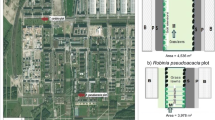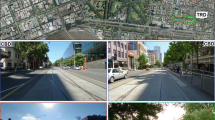Abstract
In a context of urban warming, the effects of trees on outdoor thermal stress are important even during the increasingly hot autumn season. This study examines the effects of a deciduous tree species (Tilia x europaea L) on surface temperature over different ground materials and in turn on human thermal comfort, with a particular focus on tree shade variation due to leaf fall. Grass, asphalt, and gravel-covered ground surfaces, both sun-exposed and under the Tilia, were monitored in Florence, Italy, during the summer (2014) and autumn (2017) seasons. The Index of Thermal Stress (ITS) was used to gauge the micrometeorological effects of the changing tree canopy, with tree defoliation quantified by the Plant Area Index. On clear summer days, thermal discomfort was especially pronounced over exposed asphalt, and even more intense above exposed gravel due to its higher reflectivity—while shaded surfaces showed large reductions in thermal stress. Even though incoming solar radiation decreases over the course of the fall season, the direct radiation under the gradually defoliating tree canopy actually increases. Due to this diminished shading effect, the differences in surface temperature between exposed and shaded asphalt shrink dramatically from about 20 to 3 °C. However, since ambient conditions become milder as the season progresses, the Tilia demonstrated a double benefit in terms of ITS: providing thermal comfort under its full canopy at the beginning of autumn and maintaining comfort even as its canopy thins out. At the same time, tree species with earlier defoliation may be unable to replicate such benefits.










Similar content being viewed by others
References
Attaianese E (2016) Increasing sustainability by improving full use of public space: human centred design for easy-to-walk built environment. In: Rebelo F, Soares M (eds) Advances in ergonomics in design. Advances in intelligent systems and computing vol 485. Springer, Cham
Basler D, Körner C (2012) Photoperiod sensitivity of bud burst in 14 temperate forest tree species. Agric For Meteorol 165:73–81. https://doi.org/10.1016/j.agrformet.2012.06.001
Brandani G, Napoli M, Massetti L, Petralli M, Orlandini S (2016) Urban soil: assessing ground cover impact on surface temperature and thermal comfort. J Environ Qual 45(1):90–97. https://doi.org/10.2134/jeq2014.12.0521
Bréda NJJ (2003) Ground based measurements of leaf area index: a review of methods, instruments and current controversies. J Exp Bot 54(392):2403–2417. https://doi.org/10.1093/jxb/erg263
Brunetti M, Maugeri M, Monti F, Nanni T (2006) Temperature and precipitation variability in Italy in the last two centuries from homogenised instrumental time series. Int J Climatol 26:345–381. https://doi.org/10.1002/joc.1251
Campbell GS, Norman JM, Long SP (1989) Plant physiological ecology field methods and instrumentation. In: Russell G, Marshall B, Jarvis PG (eds) Canopy structure. chapman and hall, London
Djekic J, Djukic A, Vukmirovic M, Djekic P, Brankovic MD (2018) Thermal comfort of pedestrian spaces and the influence of pavement materials on warming up during summer. Energy Build 159:474–485. https://doi.org/10.1016/j.enbuild.2017.11.004
Dorman M, Erell E, Vulkan A, Kloog I (2018) Shadow: R package for geometric shadow calculations in an urban environment. In: Introduction to the shadow R package. The R Project for Statistical Computing. https://cran.r-project.org/web/packages/shadow/vignettes/introduction.pdf. Accessed 10 July 2018
Erell ED, Pearlmutter D, Boneh Kutiel PB (2014) Effect of high-albedo materials on pedestrian heat stress in urban street canyons. Urban Clim 10(2):367–386. https://doi.org/10.1016/j.uclim.2013.10.005
Estiarte M, Penuelas J (2015) Alteration of the phenology of leaf senescence and fall in winter deciduous species by climate change: effects on nutrient proficiency. Glob Chang Biol 21:1005–1017. https://doi.org/10.1111/gcb.12804
European Commission (2010) Making our cities attractive and sustainable. How the EU contributes to improving the urban environment. Publications Office of the European Union, 36 pp. ISBN 978-92-79-16298-5, Luxembourg. https://doi.org/10.2779/42720
Fischer EM, Schär C (2009) Future changes in daily summer temperature variability: driving processes and role for temperature extremes. Clim Dyn 33:917–935. https://doi.org/10.1007/s00382-008-0473-8
Garonna I, De Jong R, De Wit AJW, Mucher CA, Schmid B, Schaepman M (2014) Strong contribution of autumn phenology to changes in satellite-derived growing season length estimates across Europe (1982– 2011). Glob Chang Biol 20:3457–3470. https://doi.org/10.1111/gcb.12625
Giorgi F (2004) Climate change hot-spots. Geophys Res Lett 33:L08707. https://doi.org/10.1029/2006GL025734
Hellström RÅ (2000) Forest cover algorithms for estimating meteorological forcing in a numerical snow model. Hydrol Process 14(18):3239–3256. https://doi.org/10.1002/1099-1085(20001230)14:18<3239::AID-HYP201>3.0.CO;2-O
Holst J, Mayer H (2011) Impacts of street design parameters on human-biometeorological variables. Meteorol Z 20(5):541–552. https://doi.org/10.1127/0941-2948/2011/0254
Holst T, Hauser S, Kirchgäßner A, Matzarakis A, Mayer H, Schindler D (2004) Measuring and modelling plant area index in beech stands. Int J Biometeorol 48(4):192–201. https://doi.org/10.1007/s00484-004-0201-y
Jolly WM, Nemani R, Running SW (2005) A generalized, bioclimatic index to predict foliar phenology in response to climate. Glob Chang Biol 11:619–632. https://doi.org/10.1111/j.1365-2486.2005.00930.x
Konarska J, Lindberg F, Larsson A, Thorsson S, Holmer B (2014) Transmissivity of solar radiation through crowns of single urban trees—application for outdoor thermal comfort modelling. Theor Appl Climatol 117(3–4):363–376. https://doi.org/10.1007/s00704-013-1000-3
Lee H, Mayer H (2018) Maximum extent of human heat stress reduction on building areas due to urban greening. Urban For Urban Green 32:154–167. https://doi.org/10.1016/j.ufug.2018.04.010
Lee H, Holst J, Mayer H (2013) Modification of human-biometeorologically significant radiant flux densities by shading as local method to mitigate heat stress in summer within urban street canyons. Adv Meteorol 2013:312572, 13 pages. https://doi.org/10.1155/2013/312572
Lee H, Mayer H, Chen L (2016) Contribution of trees and grasslands to the mitigation of human heat stress in a residential district of Freiburg, Southwest Germany. Landsc Urban Plan 148:37–50. https://doi.org/10.1016/j.landurbplan.2015.12.004
Massetti L (2018) Assessing the impact of street lighting on Platanus x acerifolia phenology. Urban For Urban Green 34:71–77. https://doi.org/10.1016/j.ufug.2018.05.015
Massetti L, Petralli M, Brandani G, Napoli M, Ferrini F, Fini A, Pearlmutter D, Orlandini S, Giuntoli A (2019) Modelling the effect of urban design on thermal comfort and air quality: The SMARTUrban Project. Build Simul. https://doi.org/10.1007/s12273-018-0490-4
Mayer H, Holst J, Dostal P, Imbery F, Schindler D (2008) Human thermal comfort in summer within an urban street canyon in Central Europe. Meteorol Z 17(3):241–250. https://doi.org/10.1127/0941-2948/2008/0285
Meehl GA, Tebaldi C (2004) More intense, more frequent, and longer lasting heat waves in the 21st century. Science 305:994–997. https://doi.org/10.1126/science.1098704
Menzel A (2003) Plant phenological anomalies in Germany and their relation to air temperature and NAO. Climate Change 57(3):243–263. https://doi.org/10.1023/A:1022880418362
Napoli M, Massetti L, Brandani G, Petralli G, Orlandini S (2016) Modeling tree shade effect on urban ground surface temperature. J Environ Qual 45(1):146–156. https://doi.org/10.2134/jeq2015.02.0097
Oke TR (1989) The micrometerology of the urban forest. Philos Trans R Soc B 324:335–349. https://doi.org/10.1098/rstb.1989.0051
Pearlmutter D, Bitan A, Berliner P (1999) Microclimatic analysis of ‘compact’ urban canyons in an arid zone. Atmos Environ 33:4143–4150. https://doi.org/10.1016/S1352-2310(99)00156-9
Pearlmutter D, Berliner P, Shaviv E (2006) Physical modeling of pedestrian energy exchange within the urban canopy. Build Environ 41(6):783–795. https://doi.org/10.1016/j.buildenv.2005.03.017
Pearlmutter D, Jiao D, Garb Y (2014) The relationship between bioclimatic thermal stress and subjective thermal sensation in pedestrian spaces. Int J Biometeorol 58:2111–2127. https://doi.org/10.1007/s00484-014-0812-x
Perry TO (1971) Dormancy of trees in winter. Science 171:29–36. https://doi.org/10.1126/science.171.3966.29
Petralli M, Massetti L, Orlandini S (2011) Five years of thermal intra-urban monitoring in Florence (Italy) and application of climatological indices. Theor Appl Climatol 104(3–4):349–356. https://doi.org/10.1007/s00704-010-0349-9
Petralli M, Morabito M, Cecchi L, Crisci A, Orlandini S (2012) Urban morbidity in summer: ambulance dispatch data, periodicity and weather. Cent Eur J Med 7(6):775–782. https://doi.org/10.2478/s11536-012-0056-2
Petralli M, Brandani G, Napoli M, Messeri A, Massetti L (2015) Thermal comfort and green areas in Florence. Ital J Agrometeorol 20(2):39–48
R Core Team (2017) R: A language and environment for statistical computing. R Foundation for Statistical Computing, Vienna URL https://www.R-project.org/. Accessed 10 July 2018
Rahman MA, Armson D, Ennos AR (2015) A comparison of the growth and cooling effectiveness of five commonly planted urban tree species. Urban Ecosystems 18(2):371–389. https://doi.org/10.1007/s11252-018-0761-y
Rahman MA, Moser A, Rötzer T, Pauleit S (2017) Within canopy temperature differences and cooling ability of Tilia cordata trees grown in urban conditions. Build Environ 114:118–128
Rahman MA, Moser A, Gold A, Rötzer T, Pauleit S (2018) Vertical air temperature gradients under the shade of two contrasting urban tree species during different types of summer days. Sci Total Environ 633:100–111
Salata F, Golasi J, Petitti D, de Lieto VE (2017) Coppi M, de Lieto Vollaro a (2017) relating microclimate, human thermal comfort and health during heat waves: an analysis of heat island mitigation strategies through a case study in an urban outdoor environment. Sustain Cities Soc 30:79–96. https://doi.org/10.1016/J.SCS.2017.01.006
Sanderson MG, Economou T, Salmon KH, Jones SEO (2017) Historical trends and variability in HeatWaves in the United Kingdom. Atmosphere 8(10):191. https://doi.org/10.3390/atmos8100191
Santamouris M, Paraponiaris K, Mihalakakou G (2007a) Estimating the ecological footprint of the heat island effect over Athens, Greece. Clim Chang 80:265–276. https://doi.org/10.1007/s10584-006-9128-0
Santamouris M, Pavlou K, Synnefa A, Niachou K, Kolokotsa D (2007b) Recent progress on passive cooling techniques: advanced technological developments to improve survivability levels in low income households. Energy Build 39:859–866. https://doi.org/10.1016/j.enbuild.2007.02.008
Schiller G, Karchon K (1974) Microclimate and recreational value of tree planning in deserts. Landscape Plan 1:329–337. https://doi.org/10.1016/0304-3924(74)90023-9
Shashua-Bar L, Pearlmutter D, Erell E (2011) The influence of trees and grass on outdoor thermal comfort in a hot-arid environment. Int J Climatol 31(10):1498–1506. https://doi.org/10.1002/joc.2177
SIR (2018) http://www.sir.toscana.it/ricerca-dati (last accessed: 17/06/2018)
Snir K, Pearlmutter D, Erell E (2016) The moderating effect of water-efficient ground cover vegetation on pedestrian thermal stress. Landsc Urban Plan 152:1–12. https://doi.org/10.1016/j.landurbplan.2016.04.008
Stockli R, Rutishauser T, Dragoni D, O’Keefe J, Thornton PE, Jolly M, Lu L, Denning AS (2008) Remote sensing data assimilation for a prognostic phenology model. J Geophys Res Biogeosci 113:G4. https://doi.org/10.1029/2008JG000781
Vallorani R, Bartolini G, Betti G, Crisci A, Gozzini B, Grifoni D, Iannuccilli M (2017) Circulation type classifications for temperature and precipitation stratification in Italy. Int J Climatol 38(2):915–931. https://doi.org/10.1002/joc.5219
Way DA, Montgomery RA (2015) Photoperiod constraints on tree phenology, performance and migration in a warming world. Plant Cell Environ 38:1725–1736
Yu Q, Jia D-R, Tian B, Yang Y-P, Duan Y-W (2016) Changes of flowering phenology and flower size in rosaceous plants from a biodiversity hotspot in the past century. Sci Rep UK 6:28302. https://doi.org/10.1038/srep28302
Zölch T, Maderspacher J, Wamsler C, Pauleit S (2016) Using green infrastructure for urban climate-proofing: an evaluation of heat mitigation measures at the micro-scale. Urban For Urban Green 20:305–316. https://doi.org/10.1016/j.ufug.2016.09.011
Acknowledgments
The authors acknowledge professor Ugo Virdia, head of school of the Istituto Tecnico Agrario Statale of Florence for having granted the space for the field experiments of this research.
Author information
Authors and Affiliations
Corresponding author
Rights and permissions
About this article
Cite this article
Massetti, L., Petralli, M., Napoli, M. et al. Effects of deciduous shade trees on surface temperature and pedestrian thermal stress during summer and autumn. Int J Biometeorol 63, 467–479 (2019). https://doi.org/10.1007/s00484-019-01678-1
Received:
Revised:
Accepted:
Published:
Issue Date:
DOI: https://doi.org/10.1007/s00484-019-01678-1




